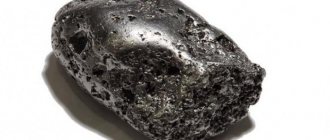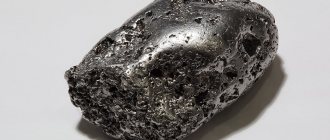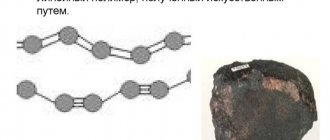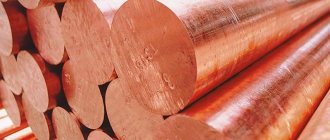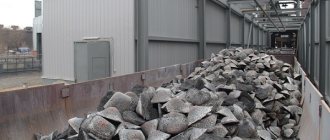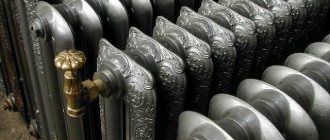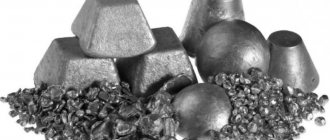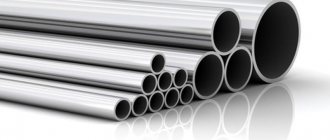Pure iron (99.97%), purified by electrolysis
Iron
- a malleable silver-white metal with high chemical reactivity: iron quickly corrodes at high temperatures or high humidity in the air. Iron burns in pure oxygen, and in a finely dispersed state it spontaneously ignites in air. Denoted by the symbol Fe (Latin Ferrum). One of the most common metals in the earth's crust (second place after aluminum).
- Structure
- Properties
- Reserves and production
- Origin
- Application
- Classification
- Physical properties
- Optical properties
- Crystallographic properties
See also:
Aluminum
– structure and physical properties
STRUCTURE
Two modifications of the iron crystal lattice
Several polymorphic modifications have been established for iron, of which the high-temperature modification - γ-Fe (above 906°) forms a lattice of a face-centered cube of the Cu type (a0 = 3.63), and the low-temperature modification - the α-Fe lattice of a centered cube of the α-Fe type (a0 = 2.86). Depending on the heating temperature, iron can be found in three modifications, characterized by different crystal lattice structures:
- In the temperature range from the lowest to 910 ° C - a-ferrite (alpha ferrite), which has a crystal lattice structure in the form of a centered cube;
- In the temperature range from 910 to 1390°C - austenite, the crystal lattice of which has the structure of a face-centered cube;
- In the temperature range from 1390 to 1535 ° C (melting point) - d-ferrite (delta ferrite). The crystal lattice of d-ferrite is the same as that of a-ferrite. The only difference between them is the different (larger for d-ferrite) distances between the atoms.
When liquid iron is cooled, primary crystals (crystallization centers) appear simultaneously at many points in the cooled volume. With subsequent cooling, new crystalline cells are built around each center until the entire supply of liquid metal is exhausted. The result is a granular structure of the metal. Each grain has a crystal lattice with a certain direction of its axes. With subsequent cooling of solid iron, during the transitions of d-ferrite to austenite and austenite to a-ferrite, new crystallization centers may appear with a corresponding change in grain size
Story
The history of iron goes back thousands of years. About 3500 years ago, as A. Azimov wrote,
“iron smelting technology was developed in the Caucasian foothills.”
Ultra-pure iron
The Hittite kingdom was located there. The warlike Hittites guarded the secret of smelting as closely as they could, which is why the price of iron was tens of times higher than the price of gold. Those who wielded iron weapons almost automatically emerged victorious in battles. And the wars were mainly fought over territories.
With the invention of welded weapons came the age of ferrous metal.
In peaceful life, iron tools had enough to do: cut down a hut, hew stone, plow a field.
PROPERTIES
Iron ore
In its pure form under normal conditions it is a solid. It has a silver-gray color and a pronounced metallic luster. The mechanical properties of iron include its level of hardness on the Mohs scale. It is equal to four (average). Iron has good electrical and thermal conductivity. The last feature can be felt by touching an iron object in a cold room. Because this material conducts heat quickly, it removes most of it from your skin in a short period of time, which is why you feel cold. If you touch, for example, wood, you will notice that its thermal conductivity is much lower. The physical properties of iron include its melting and boiling points. The first is 1539 degrees Celsius, the second is 2860 degrees Celsius. We can conclude that the characteristic properties of iron are good ductility and fusibility. But that's not all. Also, the physical properties of iron include its ferromagnetism. What it is? Iron, whose magnetic properties we can observe in practical examples every day, is the only metal that has such a unique distinctive feature. This is explained by the fact that this material is capable of magnetization under the influence of a magnetic field. And after the end of the action of the latter, the iron, the magnetic properties of which have just been formed, remains a magnet for a long time. This phenomenon can be explained by the fact that in the structure of this metal there are many free electrons that are able to move.
What is iron?
From an industrial point of view, iron is the main building material in the world. Its use is everywhere - from door handles to interplanetary rocket engines. The reason for this popularity is simple - the abundance and low cost of raw materials, because iron is in second place in terms of its share in the earth’s crust after aluminum. Symbolic designation of iron "Fe"? and its serial number according to Mendeleev is 26.
Important: do not confuse steel and iron - these are completely different terms. Iron is a pure chemical element, and steel is an alloy of ferum and carbon.
Sometimes iron in the industry is called a highly concentrated alloy with an impurity content of less than 0.7% of the total mass. In this case, the physical properties of the substance are almost not lost. Most iron-based alloys belong to the group of ferrous metals.
In its pure form, iron has good ductility, making it easy to forge but difficult to cast. The structure of the metal is 5 phases, each of which has its own crystal structure and lattice parameters. More details in the table below.
The physical properties of iron directly depend on the purity of the substance. In addition to useful alloying components, which have a positive effect on the properties of the metal, there are also negative elements that can worsen its characteristics. Examples of these could be sulfur and phosphorus, which reduce ductility, in return not providing the alloy with any of the positive properties.
Basic characteristics of iron:
- variable density depending on the residence phase of the metal. The general range is from 7.4 to 7.9 grams/cubic centimeter;
- The resistance of iron in its pure form is low. The tensile strength of ordinary technical iron is 299 MPa, but if we are talking about high-speed steel, then the tensile strength increases to a value of 2.7 GPa;
- pure iron on the Mohs scale is rated at 4 points;
- the conductivity of pure ferum is lower than that of aluminum/copper – 9.7*10^(-8);
- metal can be forged, but in its pure form cannot be cast;
- low toxicity, but not biologically inert.
The absorption of iron by the human body is only ½ of what is received, which makes the metal less dangerous for humans than other elements of the metal group. The main harm to the environment is not caused by iron in its pure form, but by waste during production - gases and slags released. More details about production, thermal characteristics and areas of application will be discussed below.
RESERVES AND PRODUCTION
Iron is one of the most common elements in the solar system, especially on the terrestrial planets, in particular on Earth. A significant part of the iron of the terrestrial planets is located in the cores of the planets, where its content is estimated to be about 90%. The iron content in the earth's crust is 5%, and in the mantle about 12%.
Iron
Iron is quite widespread in the earth's crust - it accounts for about 4.1% of the mass of the earth's crust (4th place among all elements, 2nd among metals). In the mantle and earth's crust, iron is concentrated mainly in silicates, while its content is significant in basic and ultrabasic rocks, and low in acidic and intermediate rocks. A large number of ores and minerals containing iron are known. Of greatest practical importance are red iron ore (hematite, Fe2O3; contains up to 70% Fe), magnetic iron ore (magnetite, FeFe2O4, Fe3O4; contains 72.4% Fe), brown iron ore or limonite (goethite and hydrogoethite, respectively FeOOH and FeOOH nH2O ). Goethite and hydrogoethite are most often found in weathering crusts, forming so-called “iron hats”, the thickness of which reaches several hundred meters. They can also be of sedimentary origin, falling out of colloidal solutions in lakes or coastal areas of the seas. In this case, oolitic, or legume, iron ores are formed. Vivianite Fe3(PO4)2·8H2O is often found in them, forming black elongated crystals and radial aggregates. The iron content in sea water is 1·10−5-1·10−8%. In industry, iron is obtained from iron ore, mainly from hematite (Fe2O3) and magnetite (FeO·Fe2O3). There are various ways to extract iron from ores. The most common is the domain process. The first stage of production is the reduction of iron with carbon in a blast furnace at a temperature of 2000 °C. In a blast furnace, carbon in the form of coke, iron ore in the form of agglomerate or pellets, and flux (such as limestone) are fed from above, and are met by a stream of forced hot air from below. In addition to the blast furnace process, the process of direct iron production is common. In this case, pre-crushed ore is mixed with special clay, forming pellets. The pellets are fired and treated in a shaft furnace with hot methane conversion products, which contain hydrogen. Hydrogen easily reduces iron without contaminating the iron with impurities such as sulfur and phosphorus, which are common impurities in coal. Iron is obtained in solid form and is subsequently melted in electric furnaces. Chemically pure iron is obtained by electrolysis of solutions of its salts.
Melting iron
What determines the melting point of iron? Metal production involves various technologies for its extraction from ore raw materials. The most common method for smelting iron is the blast furnace method.
Before smelting the metal, it is reduced in a furnace at a temperature of +2000 °C. To extract impurities, flux is added, which decomposes when heated to an oxide, followed by combination with silicon dioxide and the formation of slag.
In addition to the blast furnace method, iron smelting is carried out by roasting crushed ore with clay. The mixture is formed into pellets and processed in a hydrogen reduction furnace. Further smelting of iron is carried out in electric furnaces.
The properties of a metal depend on the purity of the material. For technically pure iron, the melting point is +1539 °C. Sulfur is a harmful impurity. It can only be extracted from a liquid solution. Chemically pure material is obtained by electrolysis of metal salts.
ORIGIN
Native iron
Origin telluric (terrestrial) iron is rarely found in basalt lavas (Uifak, Disko Island, off the western coast of Greenland, near Kassel, Germany). At both locations, pyrrhotite (Fe1-xS) and cohenite (Fe3C) are associated with it, which is explained by both the reduction by carbon (including from the host rocks) and the decomposition of carbonyl complexes such as Fe(CO)n. In microscopic grains, it has more than once been established in altered (serpentinized) ultrabasic rocks, also in paragenesis with pyrrhotite, sometimes with magnetite, due to which it arises during reduction reactions. Very rarely found in the oxidation zone of ore deposits, during the formation of swamp ores. Findings have been recorded in sedimentary rocks associated with the reduction of iron compounds with hydrogen and hydrocarbons. Almost pure iron was found in lunar soil, which is associated with both meteorite falls and magmatic processes. Finally, two classes of meteorites - stony-iron and iron - contain natural iron alloys as a rock-forming component.
When was it open
The history of man's acquaintance with iron begins with Space. Judging by the ancient (for example, ancient Egyptian) names of the element, it was meteorite iron. Hittite texts refer to him as "fallen from the sky."
Man has been using metal for 6 thousand years.
Archaeologists have unearthed tools used by the ancient Sumerians and Egyptians. They are made from meteorite iron.
Iron products conquered the world. The poems of Homer's Iliad are dedicated to metal, and it is mentioned by Aristotle and Strabo.
The ancient name of iron is due to its celestial origin: “sider” (“starry”).
Scientists are constantly exploring the potential of metal. Thus, in 1868, the Russian scientist D.K. Chernov discovered crystalline modifications of matter.
APPLICATION
Iron ring
Iron is one of the most used metals, accounting for up to 95% of global metallurgical production. Iron is the main component of steels and cast irons - the most important structural materials. Iron can be part of alloys based on other metals - for example, nickel. Magnetic iron oxide (magnetite) is an important material in the production of long-term computer memory devices: hard drives, floppy disks, etc. Ultrafine magnetite powder is used in many black and white laser printers mixed with polymer granules as a toner. This uses both the black color of the magnetite and its ability to stick to the magnetized transfer roller. The unique ferromagnetic properties of a number of iron-based alloys contribute to their widespread use in electrical engineering for magnetic cores of transformers and electric motors. Iron(III) chloride (ferric chloride) is used in amateur radio practice for etching printed circuit boards. Ferrous sulfate heptate (ferrous sulfate) mixed with copper sulfate is used to combat harmful fungi in gardening and construction. Iron is used as an anode in iron-nickel batteries and iron-air batteries. Aqueous solutions of ferrous and ferric chlorides, as well as its sulfates, are used as coagulants in the purification processes of natural and waste water in the water treatment of industrial enterprises.
Iron – Fe
| Molecular weight | 55.85 g/mol |
| origin of name | Possibly Anglo-Saxon origin |
| IMA status | valid, first described before 1959 (before IMA) |
Alloys
Markings help to navigate the sea of iron alloys (steels, cast irons). It will help determine the composition of the alloy, the amount of carbon and alloying elements, and distinguish their properties.
A general description can be given by chemical composition: these are carbon and alloy steels.
Steels are divided by application:
| Type and grade of steel | Application |
| Construction St0-3 | Secondary structural elements made with little responsibility (railings, decking) |
| Construction St3 | Can be used for load-bearing structures, but at positive temperatures |
| Structural St20 | Lightly loaded parts |
| Alloyed 10HSND | Used in welded structures of ship and carriage building, chemical engineering |
| Alloyed 18ХГТ | Withstands shock loads, high pressure |
| Alloyed 09G2S | For work under pressure, at temperatures from -70 to +450 degrees. |
PHYSICAL PROPERTIES
| Mineral color | iron black |
| Stroke color | grey |
| Transparency | opaque |
| Shine | metal |
| Cleavage | imperfect by {001} |
| Hardness (Mohs scale) | 4,5 |
| Kink | hackly |
| Strength | malleable |
| Density (measured) | 7.3 – 7.87 g/cm3 |
| Radioactivity (GRapi) | 0 |
| Magnetism | ferromagnet |
Biological effects
For humans, iron as a microelement (0.02%) is of special importance: it regulates cellular respiration and is part of the blood.
Health Importance
The adult human body contains 3.5 grams of iron. Of these, three quarters are included in the hemoglobin of the blood, the rest is distributed to other structures of the body.
Lack of microelement causes anemia in humans or animals, chlorosis in plants.
Nutrition
Iron is supplied to the body by food.
The foods richest in micronutrients are found in all food groups:
- Bread, cereals.
- Liver, meat.
- Eggs.
- Beets, leafy greens.
- Legumes.
- Dried fruits, nuts, seeds.
Foods contain different types of iron: heme and non-heme. Heme contains the “animal” assortment, while non-heme contains the plant variety.
Need
Daily iron requirement (mg):
- children – 4-18;
- women – 18;
- men – 10.
During pregnancy, the norm doubles. More is required for anemic people and donors.
It is easier for the body to absorb heme iron, so vegans or vegetarians need 30-33 mg daily.
The danger of oversupply
However, an excess of the substance is not welcome, since it “suppresses” the formation of antioxidants in the body.
The use of water with an iron content of more than 2 mg per liter is undesirable. If the metal content is more than 200 mg, the water is toxic.
According to Russian standards, a liter of water should contain no more than 0.3 mg of iron.
Strength of metals
In addition to the ability to transition from a solid to a liquid state, one of the important properties of a material is its strength - the ability of a solid body to resist destruction and irreversible changes in shape. The main indicator of strength is the resistance that occurs when a pre-annealed workpiece breaks. The concept of strength does not apply to mercury because it is in a liquid state. The designation of strength is adopted in MPa - Mega Pascals.
There are the following strength groups of metals:
- Fragile. Their resistance does not exceed 50MPa. These include tin, lead, soft-alkaline metals
- Durable, 50−500 MPa. Copper, aluminum, iron, titanium. Materials of this group are the basis of many structural alloys.
- High strength, over 500 MPa. For example, molybdenum and tungsten.
Metal strength table
| Metal | Resistance, MPa |
| Copper | 200−250 |
| Silver | 150 |
| Tin | 27 |
| Gold | 120 |
| Lead | 18 |
| Zinc | 120−140 |
| Magnesium | 120−200 |
| Iron | 200−300 |
| Aluminum | 120 |
| Titanium | 580 |
Chemical composition
Telluric iron contains impurities of nickel (Ni) 0.6-2%, cobalt (Co) up to 0.3%, copper (Cu) up to 0.4%, platinum (Pt) up to 0.1%, carbon. Native iron usually contains Ni in solid solution. The composition of individual varieties has not been precisely established; the analyzes are mostly old, performed on material not verified by mineragraphic and x-ray studies. Minor admixtures of Co, Cu, S, C, Mn, P, Pt, As, Ge have been identified, partly associated, apparently, with a mechanical admixture of cohenite; the presence of gas inclusions (CO and CO2) was noted.
Varieties
Ferrite (Vernadsky, 1912) is the purest, almost Ni-free native iron. Awaruite - awaruite (Skei, 1885) 6 -(Ni, Fe). Native nickel-iron with a high Ni content (Ni: Fe from 4: 1 to 2: 1). Hardness. 5. Density 8.1. It resembles polyxene in luster and color. In reflected light, pure white or light cream, isotropic, highly reflective. Named for its location in Avarua Bay (New Zealand), where it is associated with gold, platinum, cassiterite, chromite, and magnetite. It is found as a secondary mineral in peridotites that have undergone serpentinization, serpentinites, trachytes, and quartz porphyries. Varieties of nickel-iron of terrestrial origin close to or identical to awaruite, found in placers and in serpentinized peridotites, are described under the names: josephinite (Melville, 1892), souesite-souesite (Hofman, 1905), octibbehite (Taylor, 1905). 1857), catarinite - satarinite (Damur, 1877). Under the name bobrovkite (Vysotsky, 1913), nickel-iron (iron-nickel) is described, found in the form of fine-scaled grains together with platinum (polyxene) in the placers of M. Bobrovka (Ural). Contains Ni 71.93, Fe 28.07, as well as Co, Mn.
Mixed oxide Fe3O4
An interesting iron compound is a mixed oxide. Its peculiarity is that in one crystal lattice there are two iron ions at once - +2 and +3. Because they form a single complex, they are often written as a single oxide. In fact, it is a crystalline hydrate of two oxides: FeO⋅Fe2O3. It is characterized by the following reactions:
- Decomposition: Fe3O4 → 3Fe + 2O2
- Reaction with dilute acid: Fe3O4 + 4 H2SO4 → Fe2(SO4)3 + FeSO4 + 4 H2O
- Oxidation: 4Fe3O4 + 2O2 →6Fe2O3
- Fusion: Fe3O4 + 14NaOH → Na4FeO3 + 2Na5FeO4 + 7H2O
- Proportionation: Fe + Fe3O4 → 4FeO
- Reduction with hydrogen to iron and water.
Crystallographic characteristics
Cubic system
Class hexoctahedral
Crystal structure of native iron – Body-centered cubic lattice (for low-temperature modification)
Form of being in nature
The appearance of crystals. Only microscopically small ferrite crystals are known.
Twins in native iron at (111) with a fusion plane (211), often repeated.
Aggregates.
Grains, scales, wire-like sticks, curved ribbons, impregnations in rocks, sometimes large continuous deposits weighing up to several tons (ferrite), often intergrown with cohenite.
